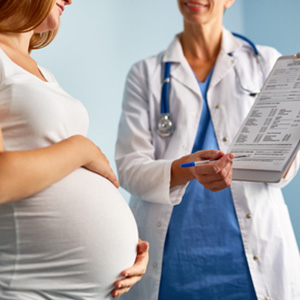
Prenatal Diagnosis
Prenatal diagnosis and prenatal screening are aspects of prenatal care that focus on detecting anatomic and physiologic problems with the zygote, embryo, or fetus as early as possible, either before gestation even starts (as in preimplantation genetic diagnosis) or as early in gestation as practicable. They use medical tests to detect problems such as neural tube defects, chromosomeabnormalities, and gene mutations that would lead to genetic disorders and birth defects, such as spina bifida, cleft palate, Tay–Sachs disease, sickle cell anemia, thalassemia, cystic fibrosis, muscular dystrophy, and fragile X syndrome. The screening focuses on finding problems among a large population with affordable and noninvasive methods, whereas the diagnosis focuses on pursuing additional detailed information once a particular problem has been found, and can sometimes be more invasive. Screening can also be used for prenatal sex discernment. Common testing procedures include amniocentesis, ultrasonography including nuchal translucency ultrasound, serum biomarker testing, or genetic screening. In some cases, the tests are administered to determine if the fetus will be aborted, though physicians and patients also find it useful to diagnose high-risk pregnancies early so that delivery can be scheduled in a tertiary care hospital where the baby can receive appropriate care
Genetic screening methods may include the following:
- Ultrasound scan.
- Alpha-fetoprotein test (AFP) or multiple marker test.
- Chorionic villus sampling (CVS)
- Amniocentesis.
- Percutaneous umbilical blood sampling (withdrawing a small sample of the fetal blood from the umbilical cord)
First Trimester Screening. First trimester screening is a combination of tests completed between weeks 11 and 13 of pregnancy. It is used to look for certain birth defects related to the baby's heart or chromosomal disorders, such as Down syndrome. This screen includes a maternal blood test and an ultrasound.
Ultrasound can detect some types of physical birth defects. Examples of physical birth defects that may be found at 19 - 20 weeks are most cases of spina bifida, some serious heart defects, some kidney problems, absence of part of a limb and some cases of cleft palate.
If a baby is born with a part of the body that is missing or malformed, it is called a structural birth defect. Heart defects are the most common type of structural defect. Others include spina bifida, cleft palate, clubfoot, and congenital dislocated hip.
Booking a visit
© 2017 Pushpaa Hospital

